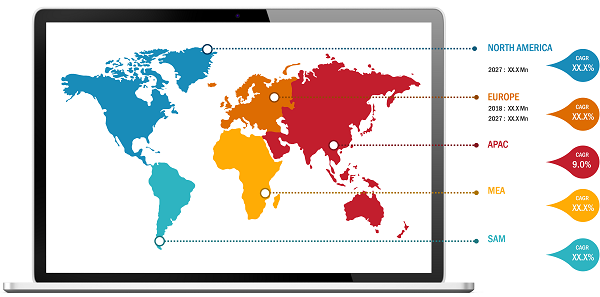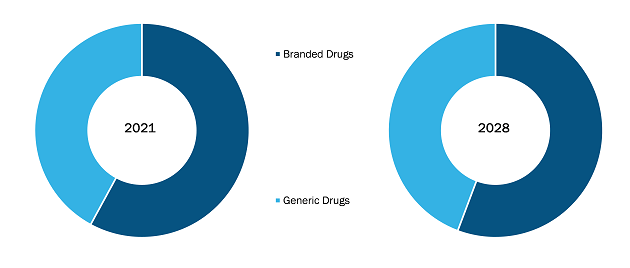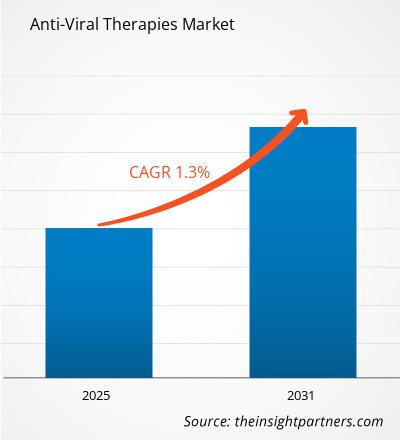Le marché mondial des thérapies antivirales devrait passer de 47 228,91 millions de dollars américains en 2021 à 82 928,76 millions de dollars américains en 2031 ; on estime qu'il connaîtra une croissance à un TCAC de 8,4 % entre 2022 et 2031.
Les thérapies antivirales impliquent le développement d'un traitement pour infections virales. Il existe plusieurs stratégies utilisées pour développer une thérapie antivirale, notamment les antiviraux à action directe qui ciblent les protéines, les enzymes ou les acides nucléiques viraux ; des anticorps passifs qui neutralisent les virus en circulation ; et les médicaments qui ciblent les protéines cellulaires ou les processus essentiels à la réplication virale.
Le le marché des thérapies antivirales est attribué à l'augmentation des dépenses de R&D des sociétés pharmaceutiques et au soutien croissant du gouvernement aux activités de recherche. et les essais cliniques. Cependant, le coût élevé du développement de médicaments entrave la croissance du marché.
Le marché des thérapies antivirales est segmenté en fonction du type et de l'application. , mécanisme d’action et géographie. Le rapport offre des informations et une analyse approfondie du marché des thérapies antivirales, en mettant l'accent sur divers paramètres tels que les tendances du marché, les progrès technologiques et la dynamique du marché, ainsi que sur l'analyse du paysage concurrentiel des principaux acteurs du marché.
Régions lucratives du marché des thérapies antivirales
 < /p>
< /p>
Market Insights
L'augmentation des dépenses de R&D dans les sociétés pharmaceutiques stimule la croissance du marché des thérapies antivirales
La recherche et le développement (R&D) constituent une partie essentielle des activités d'une entreprise. Les sociétés pharmaceutiques se concentrent sur la R&D pour introduire de nouveaux médicaments dotés d'un potentiel médical et commercial accru. Ces sociétés investissent principalement dans Activités de R&D dans le but de fournir des produits innovants de haute qualité sur le marché.
Investissements en R&D des grandes sociétés pharmaceutiques
Remarque : le taux de conversion actuel est pris en compte.
Source : Rapports annuels et analyse d'Insight Partners
Les dépenses de R&D des sociétés biopharmaceutiques ont augmenté au fil des ans. Selon le rapport de la Pharmaceutical Research and Manufacturers of America (PhRMA), les dépenses de R&D des sociétés biopharmaceutiques sont passées de 1 000 000 $ US à 1 000 000 $ US. 49,6 milliards de dollars en 2012 à 58,8 milliards de dollars en 2015. Au cours de l'exercice 2014-2015, 16 sociétés pharmaceutiques figuraient parmi les 50 premières entreprises mondiales en termes d'investissement total en R&D. Novartis, Roche, Johnson & Johnson, et Pfizer font partie des 10 principales sociétés d'investissement en R&D au monde. De plus, en 2021, Astellas Pharma a investi 1 803,70 millions de dollars américains dans la R&D de médicaments nouveaux et avancés. Ainsi, une augmentation des dépenses de R&D devrait stimuler le marché des thérapies antivirales au cours de la période de prévision.
Insights basés sur le type
En fonction du type, le marché des thérapies antivirales est divisé en médicaments génériques et médicaments de marque. Le segment des médicaments de marque détenait une part de marché plus importante en 2021 ; cependant, le segment des médicaments génériques devrait enregistrez un TCAC plus élevé au cours de la période de prévision.
&n bsp;
Marché des thérapies antivirales, par type - 2021 et 2031

Mécanisme d'informations basées sur l'action
En fonction du mécanisme d'action, le marché des thérapies antivirales est segmenté en inhibiteurs de la nucléotide polymérase, inhibiteurs de la transcriptase inverse, inhibiteurs de la protéase et autres. Le segment des inhibiteurs de la nucléotide polymérase détenait la plus grande part du marché en En outre, le segment des inhibiteurs de la transcriptase inverse devrait enregistrer le TCAC le plus élevé du marché au cours de la période de prévision en raison de son efficacité à réduire la propagation des infections virales. Par conséquent, le besoin et l'utilisation des inhibiteurs de la transcriptase inverse devraient augmenter en 2021. dans les années à venir, ce qui devrait alimenter la croissance du marché à travers le monde.
Insights basés sur les applications
En fonction des applications, le marché mondial des thérapies antivirales est segmenté en VIH, hépatite, herpès, virus de la grippe et autres applications. Le segment VIH détenait la plus grande part du marché en 2021. De plus, On estime que le segment de l'hépatite enregistrera le TCAC le plus élevé au cours de la période de prévision.
Par géographie, le marché mondial est segmenté en Amérique du Nord (États-Unis, Canada et Mexique), Europe (Royaume-Uni, Allemagne, France, Italie, Espagne et reste de l'Europe), Asie-Pacifique (Chine). , Japon, Inde, Australie, Corée du Sud et reste de l'Asie-Pacifique), du Moyen-Orient et de l'Afrique (EAU, Arabie saoudite, Afrique et reste du Moyen-Orient et de l'Afrique) et d'Amérique du Sud et centrale (Brésil, Argentine et reste de l'Amérique du Sud et de l'Amérique centrale).
Le marché des thérapies antivirales en Asie-Pacifique devrait connaître la croissance la plus rapide au cours de la période de prévision. On estime que le marché connaîtra une croissance au cours de la période de prévision en raison de la croissance de l’industrie pharmaceutique en Chine, au Japon, L'Inde et d'autres pays de la région Asie-Pacifique. L'incidence croissante des maladies virales dans la région et le développement croissant de produits par les acteurs du marché local et international sont susceptibles de favoriser la croissance du marché. En outre, l'industrie pharmaceutique chinoise est l'une des plus grandes du monde. Le pays a montré une croissance significative de l'ingrédient pharmaceutique actif fabrication, compétitivité, innovations et formation du dosage final. Par conséquent, la plupart des sociétés multinationales s'intéressent au marché chinois pour la vente de médicaments.
Les efforts croissants des gouvernements de divers pays et des sociétés pharmaceutiques et biotechnologiques pour traiter les patients atteints de COVID-19 sont susceptibles de propulser la croissance du marché des thérapies antivirales au cours de la période de prévision. Aux États-Unis, la FDA a approuvé l'autorisation d'utilisation d'urgence de médicaments expérimentaux. Essais cliniques sur le remdesivir, monoclonal Les anticorps, les interférons, les inhibiteurs de l'ECA et l'hydroxychloroquine ont tous été enregistrés aux États-Unis. En outre, les sociétés pharmaceutiques du pays déploient d'énormes efforts pour développer des médicaments et des vaccins pour le traitement des patients atteints du COVID-19. En juin 2021, des scientifiques de l’Université d’Oxford ont testé des médicaments existants comme thérapies pour les patients atteints du COVID-19. De plus, la Commission européenne a autorisé en juillet le remdesivir, ce qui en fait le premier médicament approuvé pour le traitement du COVID-19 dans l'Union européenne.
Profils d'entreprise
Quelques-uns des principaux acteurs opérant sur le marché des thérapies antivirales incluent AbbVie Inc. ; Abbé ; F. Hoffmann-La Roche SA; Société Bristol-Myers Squibb ; Johnson & Services Johnson, Inc. ; Merck et Co., Inc. ; Gilead Sciences, Inc. ; GlaxoSmithKline plc ; et Aurobindo Pharma Limitée.
- Analyse historique (2 ans), année de base, prévision (7 ans) avec TCAC
- Analyse PEST et SWO
- Taille du marché Valeur / Volume - Mondial, Régional, Pays
- Industrie et paysage concurrentiel
- Ensemble de données Excel


- Integrated Platform Management System Market
- Electronic Data Interchange Market
- Compounding Pharmacies Market
- Virtual Pipeline Systems Market
- High Speed Cable Market
- Sleep Apnea Diagnostics Market
- UV Curing System Market
- Industrial Valves Market
- Identity Verification Market
- Analog-to-Digital Converter Market

Report Coverage
Revenue forecast, Company Analysis, Industry landscape, Growth factors, and Trends

Segment Covered
This text is related
to segments covered.

Regional Scope
North America, Europe, Asia Pacific, Middle East & Africa, South & Central America

Country Scope
This text is related
to country scope.
Questions fréquemment posées
Key companies in the Anti-Viral Therapies Market are - AbbVie Inc., Abbott, F. Hoffmann-La Roche Ltd, Bristol-Myers Squibb Company, Johnson & Johnson Services, Inc., Merck and Co., Inc., Gilead Sciences, Inc., GlaxoSmithKline plc, Aurobindo Pharma
The report can be delivered in PDF/PPT format; we can also share excel dataset based on the request.
The Anti-Viral Therapies Market is expected to register a CAGR of 1.3% from 2025-2031.
The major driving factors supporting the Anti-Viral Therapies Market growth are- Increasing Incidences of Viral Infection, Government Initiatives and Financing, and Advancements and Development in Antiviral Therapy
Key Future Trends in the Anti-Viral Therapies Market are- Shift Toward Broad-Spectrum Antivirals, mRNA and Gene Therapy Innovations, and Increased Focus on Personalized Medicine in Antiviral Therapy
Some of the customization options available based on request are additional 3–5 company profiles and country-specific analysis of 3–5 countries of your choice. Customizations are to be requested/discussed before making final order confirmation, as our team would review the same and check the feasibility.
Trends and growth analysis reports related to Life Sciences : READ MORE..
The List of Companies - Anti- Viral Therapies Market
- AbbVie Inc.
- Abbott
- F. Hoffmann-La Roche Ltd
- Bristol-Myers Squibb Company
- Johnson & Johnson Services, Inc.
- Merck and Co., Inc.
- Gilead Sciences, Inc.
- GlaxoSmithKline plc
- Aurobindo Pharma
- AstraZeneca
The Insight Partners performs research in 4 major stages: Data Collection & Secondary Research, Primary Research, Data Analysis and Data Triangulation & Final Review.
- Data Collection and Secondary Research:
As a market research and consulting firm operating from a decade, we have published and advised several client across the globe. First step for any study will start with an assessment of currently available data and insights from existing reports. Further, historical and current market information is collected from Investor Presentations, Annual Reports, SEC Filings, etc., and other information related to company’s performance and market positioning are gathered from Paid Databases (Factiva, Hoovers, and Reuters) and various other publications available in public domain.
Several associations trade associates, technical forums, institutes, societies and organization are accessed to gain technical as well as market related insights through their publications such as research papers, blogs and press releases related to the studies are referred to get cues about the market. Further, white papers, journals, magazines, and other news articles published in last 3 years are scrutinized and analyzed to understand the current market trends.
- Primary Research:
The primarily interview analysis comprise of data obtained from industry participants interview and answers to survey questions gathered by in-house primary team.
For primary research, interviews are conducted with industry experts/CEOs/Marketing Managers/VPs/Subject Matter Experts from both demand and supply side to get a 360-degree view of the market. The primary team conducts several interviews based on the complexity of the markets to understand the various market trends and dynamics which makes research more credible and precise.
A typical research interview fulfils the following functions:
- Provides first-hand information on the market size, market trends, growth trends, competitive landscape, and outlook
- Validates and strengthens in-house secondary research findings
- Develops the analysis team’s expertise and market understanding
Primary research involves email interactions and telephone interviews for each market, category, segment, and sub-segment across geographies. The participants who typically take part in such a process include, but are not limited to:
- Industry participants: VPs, business development managers, market intelligence managers and national sales managers
- Outside experts: Valuation experts, research analysts and key opinion leaders specializing in the electronics and semiconductor industry.
Below is the breakup of our primary respondents by company, designation, and region:

Once we receive the confirmation from primary research sources or primary respondents, we finalize the base year market estimation and forecast the data as per the macroeconomic and microeconomic factors assessed during data collection.
- Data Analysis:
Once data is validated through both secondary as well as primary respondents, we finalize the market estimations by hypothesis formulation and factor analysis at regional and country level.
- Macro-Economic Factor Analysis:
We analyse macroeconomic indicators such the gross domestic product (GDP), increase in the demand for goods and services across industries, technological advancement, regional economic growth, governmental policies, the influence of COVID-19, PEST analysis, and other aspects. This analysis aids in setting benchmarks for various nations/regions and approximating market splits. Additionally, the general trend of the aforementioned components aid in determining the market's development possibilities.
- Country Level Data:
Various factors that are especially aligned to the country are taken into account to determine the market size for a certain area and country, including the presence of vendors, such as headquarters and offices, the country's GDP, demand patterns, and industry growth. To comprehend the market dynamics for the nation, a number of growth variables, inhibitors, application areas, and current market trends are researched. The aforementioned elements aid in determining the country's overall market's growth potential.
- Company Profile:
The “Table of Contents” is formulated by listing and analyzing more than 25 - 30 companies operating in the market ecosystem across geographies. However, we profile only 10 companies as a standard practice in our syndicate reports. These 10 companies comprise leading, emerging, and regional players. Nonetheless, our analysis is not restricted to the 10 listed companies, we also analyze other companies present in the market to develop a holistic view and understand the prevailing trends. The “Company Profiles” section in the report covers key facts, business description, products & services, financial information, SWOT analysis, and key developments. The financial information presented is extracted from the annual reports and official documents of the publicly listed companies. Upon collecting the information for the sections of respective companies, we verify them via various primary sources and then compile the data in respective company profiles. The company level information helps us in deriving the base number as well as in forecasting the market size.
- Developing Base Number:
Aggregation of sales statistics (2020-2022) and macro-economic factor, and other secondary and primary research insights are utilized to arrive at base number and related market shares for 2022. The data gaps are identified in this step and relevant market data is analyzed, collected from paid primary interviews or databases. On finalizing the base year market size, forecasts are developed on the basis of macro-economic, industry and market growth factors and company level analysis.
- Data Triangulation and Final Review:
The market findings and base year market size calculations are validated from supply as well as demand side. Demand side validations are based on macro-economic factor analysis and benchmarks for respective regions and countries. In case of supply side validations, revenues of major companies are estimated (in case not available) based on industry benchmark, approximate number of employees, product portfolio, and primary interviews revenues are gathered. Further revenue from target product/service segment is assessed to avoid overshooting of market statistics. In case of heavy deviations between supply and demand side values, all thes steps are repeated to achieve synchronization.
We follow an iterative model, wherein we share our research findings with Subject Matter Experts (SME’s) and Key Opinion Leaders (KOLs) until consensus view of the market is not formulated – this model negates any drastic deviation in the opinions of experts. Only validated and universally acceptable research findings are quoted in our reports.
We have important check points that we use to validate our research findings – which we call – data triangulation, where we validate the information, we generate from secondary sources with primary interviews and then we re-validate with our internal data bases and Subject matter experts. This comprehensive model enables us to deliver high quality, reliable data in shortest possible time.

 Obtenez un échantillon gratuit pour ce rapport
Obtenez un échantillon gratuit pour ce rapport